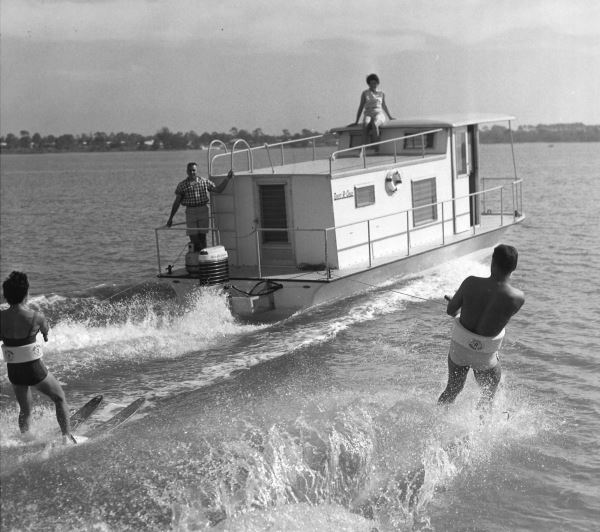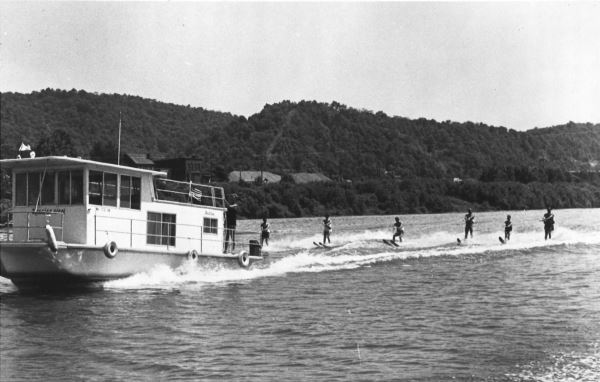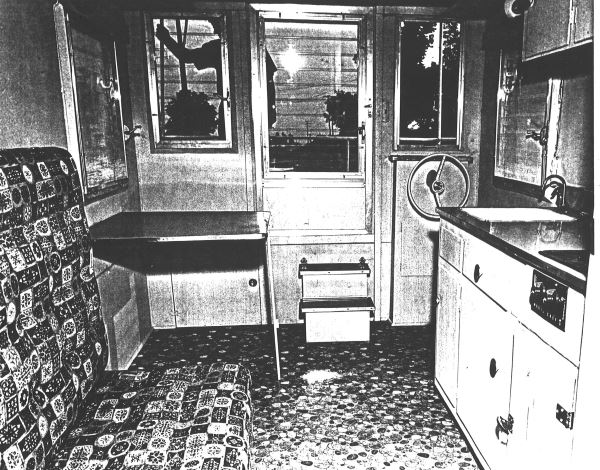
If you’re interested in houseboating history, you might be curious when the first fiberglass houseboats were produced. The first that came about was in the early 1960s. It was created by Jack McKee of Gallatin, Tenn., and known as the Drift-R-Cruz. McKee died on March 23, 1966 at age 47 from a heart attack. He attended the University of Tennessee; there, he was a member of Phi Kappa Alpha fraternity. He is also a World War II veteran. He seldom found time to go houseboating himself, but he found happiness dispatching a fleet of trucks delivering the houseboats he produced for the Drift-R-Cruz business.
 McKee’s first Drift-R-Cruz was 28 feet long and had a 75hp Mercury outboard bolted to its stern. He introduced it at a Chicago trade show, and in 1961, he tested the 75hp Mercury-powered vessel. He was blown away by its performance; it could reach speeds of up to 40 mph and pull more than five water skiers. When boaters found out about this, sales of this vessel took off and Drift-R-Cruz became the name of Jack McKee’s business. After all, who wouldn’t want a floating home that could also be used as a fast-moving means of transportation? That’s why it was called the Drift-R-Cruz. It was literally a summer cottage on the water that could drift or cruise, yet it was less than half the price of a comparably-sized yacht! It changed the way people looked at nautical living.
McKee’s first Drift-R-Cruz was 28 feet long and had a 75hp Mercury outboard bolted to its stern. He introduced it at a Chicago trade show, and in 1961, he tested the 75hp Mercury-powered vessel. He was blown away by its performance; it could reach speeds of up to 40 mph and pull more than five water skiers. When boaters found out about this, sales of this vessel took off and Drift-R-Cruz became the name of Jack McKee’s business. After all, who wouldn’t want a floating home that could also be used as a fast-moving means of transportation? That’s why it was called the Drift-R-Cruz. It was literally a summer cottage on the water that could drift or cruise, yet it was less than half the price of a comparably-sized yacht! It changed the way people looked at nautical living.
 The Drift-R-Cruz made Jack McKee the king of houseboaters for almost six years until his death in 1966; he outsold the rest of the industry combined. After his death, the company was acquired by Thunderbird Products, which continued production of this unique boat. By then, the Drift-R-Cruz increased to 40 feet in length and featured a deck, hull, and cabin exterior made entirely of skid-proof fiberglass; the hull also provided high stability. The vessel also had a beautiful carpeted and mahogany-finished interior and featured loads of drawer, cabinet, and closet space; you didn’t need to worry about leaving any gear behind. It also included a full galley with cooking appliances, a spacious dinette, and a full bathroom with a shower. The dinette and multiple couches could be converted into sleeping accommodations for six. It had plenty of windows (including rearview ones) and spacious decks. The 40-foot boat featured twin 210hp Chrysler inboard-outboard engines for power.
The Drift-R-Cruz made Jack McKee the king of houseboaters for almost six years until his death in 1966; he outsold the rest of the industry combined. After his death, the company was acquired by Thunderbird Products, which continued production of this unique boat. By then, the Drift-R-Cruz increased to 40 feet in length and featured a deck, hull, and cabin exterior made entirely of skid-proof fiberglass; the hull also provided high stability. The vessel also had a beautiful carpeted and mahogany-finished interior and featured loads of drawer, cabinet, and closet space; you didn’t need to worry about leaving any gear behind. It also included a full galley with cooking appliances, a spacious dinette, and a full bathroom with a shower. The dinette and multiple couches could be converted into sleeping accommodations for six. It had plenty of windows (including rearview ones) and spacious decks. The 40-foot boat featured twin 210hp Chrysler inboard-outboard engines for power.
If you remember the 1960s, you probably hadn’t seen a better invitation for water-borne fun in the sun. Although Thunderbird ceased production of this vessel in 1968 due to a change in company ownership and contracts, Jack McKee’s legacy and industry influence continues today with many companies producing fiberglass houseboats.